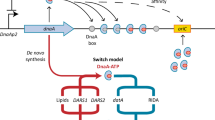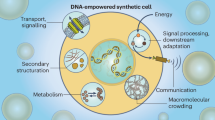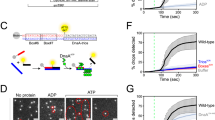Abstract
Regulating DNA replication is essential for all living cells. The DNA replication initiation factor DnaA is highly conserved in prokaryotes and is required for accurate initiation of chromosomal replication at oriC. DnaA-independent free-living bacteria have not been identified. The dnaA gene is absent in plastids and some symbiotic bacteria, although it is not known when or how DnaA-independent mechanisms were acquired. Here, we show that the degree of dependency of DNA replication on DnaA varies among cyanobacterial species. Deletion of the dnaA gene in Synechococcus elongatus PCC 7942 shifted DNA replication from oriC to a different site as a result of the integration of an episomal plasmid. Moreover, viability during the stationary phase was higher in dnaA disruptants than in wild-type cells. Deletion of dnaA did not affect DNA replication or cell growth in Synechocystis sp. PCC 6803 or Anabaena sp. PCC 7120, indicating that functional dependency on DnaA was already lost in some nonsymbiotic cyanobacterial lineages during diversification. Therefore, we proposed that cyanobacteria acquired DnaA-independent replication mechanisms before symbiosis and such an ancestral cyanobacterium was the sole primary endosymbiont to form a plastid precursor.
Similar content being viewed by others
Log in or create a free account to read this content
Gain free access to this article, as well as selected content from this journal and more on nature.com
or
References
Akman L, Yamashita A, Watanabe H, Oshima K, Shiba T, Hattori M et al. (2002). Genome sequence of the endocellular obligate symbiont of tsetse flies, Wigglesworthia glossinidia. Nat Genet 32: 402–407.
Arakawa K, Tomita M . (2007). The GC skew index: a measure of genomic compositional asymmetry and the degree of replicational selection. Evol Bioinform Online 3: 159–168.
Chen AH, Afonso B, Silver PA, Savage DF . (2012). Spatial and temporal organization of chromosome duplication and segregation in the cyanobacterium Synechococcus elongatus PCC 7942. PLoS One 7: e47837.
Chen Y, Holtman CK, Magnuson RD, Youderian PA, Golden SS . (2008). The complete sequence and functional analysis of pANL, the large plasmid of the unicellular freshwater cyanobacterium Synechococcus elongatus PCC 7942. Plasmid 59: 176–192.
Criscuolo A, Gribaldo S . (2011). Large-scale phylogenomic analyses indicate a deep origin of primary plastids within cyanobacteria. Mol Biol Evol 28: 3019–3032.
Deusch O, Landan G, Roettger M, Gruenheit N, Kowallik KV, Allen JF et al. (2008). Genes of cyanobacterial origin in plant nuclear genomes point to a heterocyst-forming plastid ancestor. Mol Biol Evol 25: 748–761.
Falcon LI, Magallon S,, Castillo A . (2010). Dating the cyanobacterial ancestor of the chloroplast. ISME J 4: 777–783.
Frank AC, Lobry JR . (1999). Asymmetric substitution patterns: a review of possible underlying mutational or selective mechanisms. Gene 238: 65–77.
Gao F . (2014). Recent advances in the identification of replication origins based on the Z-curve method. Curr Genomics 15: 104–112.
Gao F . (2015). Bacteria may have multiple replication origins. Front Microbiol 6: 324.
Gowrishankar J . (2015). End of the beginning: elongation and termination features of alternative modes of chromosomal replication initiation in bacteria. PLoS Genet 11: e1004909.
Hawkins M, Malla S, Blythe MJ, Nieduszynski CA, Allers T . (2013). Accelerated growth in the absence of DNA replication origins. Nature 503: 544–547.
Herrero A, Flores FG . (2008) The Cyanobacteria: Molecular Biology, Genomics, and Evolution. Caister Academic Press: Norfolk, UK.
Holtzendorff J, Partensky F, Jacquet S, Bruyant F, Marie D, Garczarek L et al. (2001). Diel expression of cell cycle-related genes in synchronized cultures of Prochlorococcus sp. strain PCC 9511. J Bacteriol 183: 915–920.
Imamura S, Hanaoka M, Tanaka K . (2008). The plant-specific TFIIB-related protein, pBrp, is a general transcription factor for RNA polymerase I. EMBO J 27: 2317–2327.
Ishikawa S, Ogura Y, Yoshimura M, Okumura H, Cho E, Kawai Y et al. (2007). Distribution of stable DnaA-binding sites on the Bacillus subtilis genome detected using a modified ChIP-chip method. DNA Res 14: 155–168.
Jain IH, Vijayan V, O'Shea EK . (2012). Spatial ordering of chromosomes enhances the fidelity of chromosome partitioning in cyanobacteria. Proc Natl Acad Sci USA 109: 13638–13643.
Katayama T, Ozaki S, Keyamura K, Fujimitsu K . (2010). Regulation of the replication cycle: conserved and diverse regulatory systems for DnaA and oriC. Nat Rev Microbiol 8: 163–170.
Kleine T, Maier UG, Leister D . (2009). DNA transfer from organelles to the nucleus: the idiosyncratic genetics of endosymbiosis. Annu Rev Plant Biol 60: 115–138.
Li B, Lopes JS, Foster PG, Embley TM, Cox CJ . (2014). Compositional biases among synonymous substitutions cause conflict between gene and protein trees for plastid origins. Mol Biol Evol 31: 1697–1709.
Lindahl G, Hirota Y, Jacob F . (1971). On the process of cellular division in Escherichia coli: replication of the bacterial chromosome under control of prophage P2. Proc Natl Acad Sci USA 68: 2407–2411.
Lobry JR, Sueoka N . (2002). Asymmetric directional mutation pressures in bacteria. Genome Biol 3: RESEARCH0058.
Lobry JR, Louarn JM . (2003). Polarisation of prokaryotic chromosomes. Curr Opin Microbiol 6: 101–108.
Louarn J, Patte J, Louarn JM . (1982). Suppression of Escherichia coli dnaA46 mutations by integration of plasmid R100.1. derivatives: constraints imposed by the replication terminus. J Bacteriol 151: 657–667.
McAdams HH, Shapiro L . (2009). System-level design of bacterial cell cycle control. FEBS Lett 583: 3984–3991.
Messer W, Weigel C . (1997). DnaA initiator—also a transcription factor. Mol Microbiol 24: 1–6.
Moriyama T, Sato N . (2014). Enzymes involved in organellar DNA replication in photosynthetic eukaryotes. Front Plant Sci 5: 480.
Moriyama T, Terasawa K, Sato N . (2011). Conservation of POPs, the plant organellar DNA polymerases, in eukaryotes. Protist 162: 177–187.
Moriyama T, Tajima N, Sekine K, Sato N . (2014). Localization and phylogenetic analysis of enzymes related to organellar genome replication in the unicellular rhodophyte Cyanidioschyzon merolae. Genome Biol Evol 6: 228–237.
Nakayama T, Kamikawa R, Tanifuji G, Kashiyama Y, Ohkouchi N, Archibald JM et al. (2014). Complete genome of a nonphotosynthetic cyanobacterium in a diatom reveals recent adaptations to an intracellular lifestyle. Proc Natl Acad Sci USA 111: 11407–11412.
Nishimura Y, Caro L, Berg CM, Hirota Y . (1971). Chromosome replication in Escherichia coli. IV. Control of chromosome replication and cell division by an integrated episome. J Mol Biol 55: 441–456.
Ochoa de Alda JA, Esteban R, Diago ML, Houmard J . (2014). The plastid ancestor originated among one of the major cyanobacterial lineages. Nat Commun 5: 4937.
Ohbayashi R, Watanabe S, Kanesaki Y, Narikawa R, Chibazakura T, Ikeuchi M et al. (2013). DNA replication depends on photosynthetic electron transport in cyanobacteria. FEMS Microbiol Lett 344: 138–144.
Ran L, Larsson J, Vigil-Stenman T, Nylander JA, Ininbergs K, Zheng WW et al. (2010). Genome erosion in a nitrogen-fixing vertically transmitted endosymbiotic multicellular cyanobacterium. PLoS One 5: e11486.
Reyes-Prieto A, Weber AP, Bhattacharya D . (2007). The origin and establishment of the plastid in algae and plants. Annu Rev Genet 41: 147–168.
Richter S, Hagemann M, Messer W . (1998). Transcriptional analysis and mutation of a dnaA-like gene in Synechocystis sp. strain PCC 6803. J Bacteriol 180: 4946–4949.
Scholefield G, Veening JW, Murray H . (2011). DnaA and ORC: more than DNA replication initiators. Trends Cell Biol 21: 188–194.
Shih PM, Wu D, Latifi A, Axen SD, Fewer DP, Talla E et al. (2013). Improving the coverage of the cyanobacterial phylum using diversity-driven genome sequencing. Proc Natl Acad Sci USA 110: 1053–1058.
Tamura K, Stecher G, Peterson D, Filipski A, Kumar S . (2013). MEGA6: Molecular Evolutionary Genetics Analysis version 6.0. Mol Biol Evol 30: 2725–2729.
Turner S, Pryer KM, Miao VP, Palmer JD . (1999). Investigating deep phylogenetic relationships among cyanobacteria and plastids by small subunit rRNA sequence analysis. J Eukaryot Microbiol 46: 327–338.
Watanabe S, Ohbayashi R, Shiwa Y, Noda A, Kanesaki Y, Chibazakura T et al. (2012). Light-dependent and asynchronous replication of cyanobacterial multi-copy chromosomes. Mol Microbiol 83: 856–865.
Watanabe S, Hanaoka M, Ohba Y, Ono T, Ohnuma M, Yoshikawa H et al. (2013). Mitochondrial localization of ferrochelatase in a red alga Cyanidioschyzon merolae. Plant Cell Physiol 54: 1289–1295.
Acknowledgements
We thank Drs Kazuharu Arakawa and Motohiro Akashi for advice on bioinformatics analyses; Dr Yuh Shiwa for advice on the analysis of next-generation sequencing data; and Tomoko Kojima for comments on the manuscript. This study was funded by the Sasagawa Scientific Research Grant from the Japan Science Society (to RO), by the MEXT-supported Program for Strategic Research Foundation at Private Universities, 2013–2017 (S1311017), by Grant-in-Aid for Scientific Research (C) to YK (15K07368), and by Grants-in-Aid for Young Scientists (B) to SW (25850056).
Author contributions
RO, SW and HY designed the experiments. RO performed the experiments. SE constructed Anabaena mutant strains. RO and YK analyzed Repli-seq and RNA sequencing data. RO, SW, YK, SE, TC and HY wrote the paper.
Author information
Authors and Affiliations
Corresponding author
Ethics declarations
Competing interests
The authors declare no conflict of interest.
Additional information
Supplementary Information accompanies this paper on The ISME Journal website
Supplementary information
Rights and permissions
About this article
Cite this article
Ohbayashi, R., Watanabe, S., Ehira, S. et al. Diversification of DnaA dependency for DNA replication in cyanobacterial evolution. ISME J 10, 1113–1121 (2016). https://doi.org/10.1038/ismej.2015.194
Received:
Revised:
Accepted:
Published:
Issue date:
DOI: https://doi.org/10.1038/ismej.2015.194
This article is cited by
-
The bacterial cell cycle, chromosome inheritance and cell growth
Nature Reviews Microbiology (2019)



